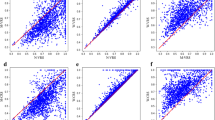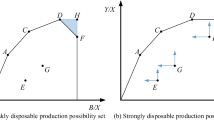Abstract
This paper examines total-factor environmental performance for various regions in China based on the metafrontier directional distance function. This approach can measure the environmental performance of undesirable outputs (pollutants). Technological heterogeneity can be taken into account simultaneously by taking a metafrontier approach. First, the concept of a generalized metafrontier directional distance function is proposed for the model. Second, several standardized composite indicators of environmental performance are developed. Third, the metafrontier directional distance function is estimated by solving a series of data envelopment analysis models. Finally, various regions in China are empirically examined, and the results and their implications are discussed. The results indicate substantial heterogeneity in environmental performance across regions, and some policy suggestions are proposed based on these results.


Similar content being viewed by others
Notes
To measure the environmental performance, we selected \(\hbox {SO}_{2}\) emissions, COD, and \(\hbox {CO}_{2}\) emissions as three outputs, because these pollutants are regulated in the 11th Five-Year Plan and have their own reduction targets.
The arithmetic average of variable numbers is widely used as the weights (Zhou et al. 2012), alternatively, the range-adjusted measure (RAM) approach could be also employed for deciding the weight for DDF.
To conduct the convergence test of environmental technology gap for China’s regions using regression is an interesting extension for this study. We thank one referee for suggesting this issue.
References
Battese, G. E., Rao, D. S. P., & O’Donnell, C. J. (2004). A metafrontier production function for estimation of technical efficiencies and technology gaps for firms operating under different technologies. Journal of Productivity Analysis, 21, 91–103.
Chen, S., & Golley, J. (2014). ‘Green’ productivity growth in China’s industrial economy. Energy Economics, 44, 89–98.
Choi, Y., Zhang, N., & Zhou, P. (2012). Efficiency and abatement costs of energy related \(\text{ CO }_{2}\) emissions in China: A slacks-based efficiency measure. Applied Energy, 98, 198–208.
Choi, Y., & Lee, E. Y. (2009). Optimizing risk management for the sustainable performance of the Regional Innovation system in Korea through meta-mediation. Human and Ecological Risk Assessment, 15, 270–280.
Chung, Y. H., Färe, R., & Grosskopf, S. (1997). Productivity and undesirable outputs: A directional distance function approach. Journal of Environmental Management, 51, 229–240.
Färe, R., & Grosskopf, S. (2005). New directions: Efficiency and Productivity. New York: Springer.
Färe, R., & Grosskopf, S. (2010). Directional distance functions and slacks-based measures of efficiency. European Journal of Operational Research, 200, 320–322.
Färe, R., Grosskopf, S., Lovell, C. A. K., & Pasurka, C. (1989). Multilateral productivity comparisons when some outputs are undesirable: A nonparametric approach. Review of Economics and Statistics, 71, 90–98.
Hoang, V., & Nguyen, T. (2013). Analysis of environmental efficiency variations: A nutrient balance approach. Ecological Economics, 86, 37–46.
IPCC. (2006). IPCC Guidelines for National Greenhouse Gas Inventories. Retrieved from http://www.ipcc-nggip.iges.or.jp/public/2006gl/vol2.html.
Kumar, S. (2006). Environmentally sensitive productivity growth: A global analysis using Malmquist–Luenberger index. Ecological Economics, 56, 280–293.
Lozano, S., & Gutiérrez, E. (2008). Non-parametric frontier approach to modelling the relationships among population, GDP, energy consumption and \(\text{ CO }_{2}\) emissions. Ecological Economics, 66, 687–699.
Long, X., Oh, K., & Cheng, G. (2013). Are stronger environmental regulations effective in practice? The case of China’s accession to the WTO. Journal of Cleaner Production, 39, 161–167.
Murty, S., Russell, R., & Levkoff, B. (2012). On modeling pollution-generating technologies. Journal of Environmental Economics and Management, 64, 117–135.
National Bureau of Statistics of China (NBSC). (2002a–2010a). China statistical year book 2010. Beijing: China Statistics Press.
National Bureau of Statistics of China (NBSC). (2002b–2010b). China energy statistical year book. Beijing: China Statistics Press.
O’Donnell, C. J., Rao, D. S. P., & Battese, G. E. (2008). Metafrontier frameworks for the study of firm-level efficiencies and technology ratios. Empirical Economics, 34, 231–255.
Oh, D. H. (2010). A metafrontier approach for measuring an environmentally sensitive productivity growth index. Energy Economics, 32, 146–157.
Oh, D. H., & Lee, J. D. (2010). A metafrontier approach for measuring Malmquist productivity index. Empirical Economics, 32, 46–64.
Picazo-Tadeo, A. J., & Diego, P. (2009). Environmental externalities and efficiency measurement. Journal of Environmental Management, 90, 3332–3339.
Picazo-Tadeo, A. J., Beltrán-Esteve, M., & Gómez-Limón, J. A. (2012). Assessing eco-efficiency with directional distance functions. European Journal of Operational Research, 220, 798–809.
Porter, M., & van der Linde, C. (1995). Toward a new conception of the environment: Competitiveness relationship. Journal of Economic Perspectives, 9, 120–134.
Ramanathan, R. (2002). Combining indicators of energy consumption and \(\text{ CO }_{2}\) emissions: A cross-country comparison. International Journal of Global Energy Issues, 17, 214–227.
Wang, H., Zhou, P., & Zhou, D. Q. (2013). Scenario-based energy efficiency and productivity in China: A non-radial directional distance function analysis. Energy Economics, 40, 795–803.
Weber, W., & Domazlicky, B. (2001). Productivity growth and pollution in state manufacturing. Review of Economics and Statistics, 83, 195–199.
Wu, Y. (2009). China’s capital stock series by region and sector. The University of Western Australia Discussion Paper 09.02.
Wu, Y. (2010). Regional environmental performance and its determinants in China. China and World Economy, 18, 73–89.
Zhang, B., Bi, J., Fan, Z., Yuan, Z., & Ge, J. (2008). Eco-efficiency analysis of industrial system in China: A data envelopment analysis approach. Ecological Economics, 68, 306–316.
Zhang, N., & Choi, Y. (2013). Total-factor carbon emission performance of fossil fuel power plants in China: A metafrontier non-radial Malmquist index analysis. Energy Economics, 40, 549–559.
Zhang, N., Zhou, P., & Choi, Y. (2013). Energy efficiency, \(\text{ CO }_{2}\) emission performance and technology gaps in fossil fuel electricity generation in Korea: A meta-frontier non-radial directional distance function analysis. Energy Policy, 56, 653–662.
Zhang, N., Kong, F., Choi, Y., & Zhou, P. (2014). The effect of size-control policy on unified energy and carbon efficiency for Chinese fossil fuel power plants. Energy Policy, 70, 193–200.
Zhang, N., & Choi, Y. (2014). A note on the evolution of directional distance function and its development in energy and environmental studies 1997–2013. Renewable and Sustainable Energy Reviews, 33, 50–59.
Zhou, P., & Ang, B. W. (2009). Comparing MCDA aggregation methods in constructing composite indicators using the Shannon-Spearman measure. Social Indicators Research, 94, 83–96.
Zhou, P., Ang, B. W., & Poh, K. L. (2008). A survey of data envelopment analysis in energy and environmental studies. European Journal of Operational Research, 189, 1–18.
Zhou, P., Ang, B. W., & Wang, H. (2012). Energy and \(\text{ CO }_{2}\) emission performance in electricity generation: A non-radial directional distance function approach. European Journal of Operational Research, 221, 625–635.
Acknowledgments
We thank two anonymous referees for the very useful suggestions on an earlier draft of this article. We also thank the financial support provided by the Major Project of National Social Science Foundation, China (12&ZD213), the National Science Foundation of China (41461118), the China Postdoctoral Foundation (2014M551849), and the start-up research fund of JUFE (61152012).
Author information
Authors and Affiliations
Corresponding author
Rights and permissions
About this article
Cite this article
Yu, Y., Choi, Y. Measuring Environmental Performance Under Regional Heterogeneity in China: A Metafrontier Efficiency Analysis. Comput Econ 46, 375–388 (2015). https://doi.org/10.1007/s10614-014-9464-5
Accepted:
Published:
Issue Date:
DOI: https://doi.org/10.1007/s10614-014-9464-5




